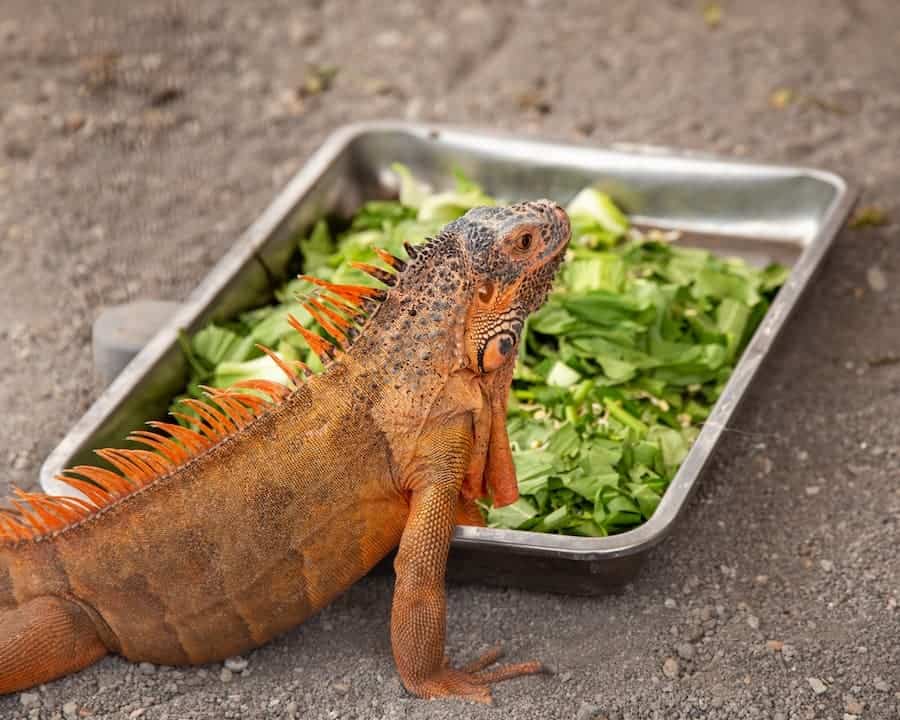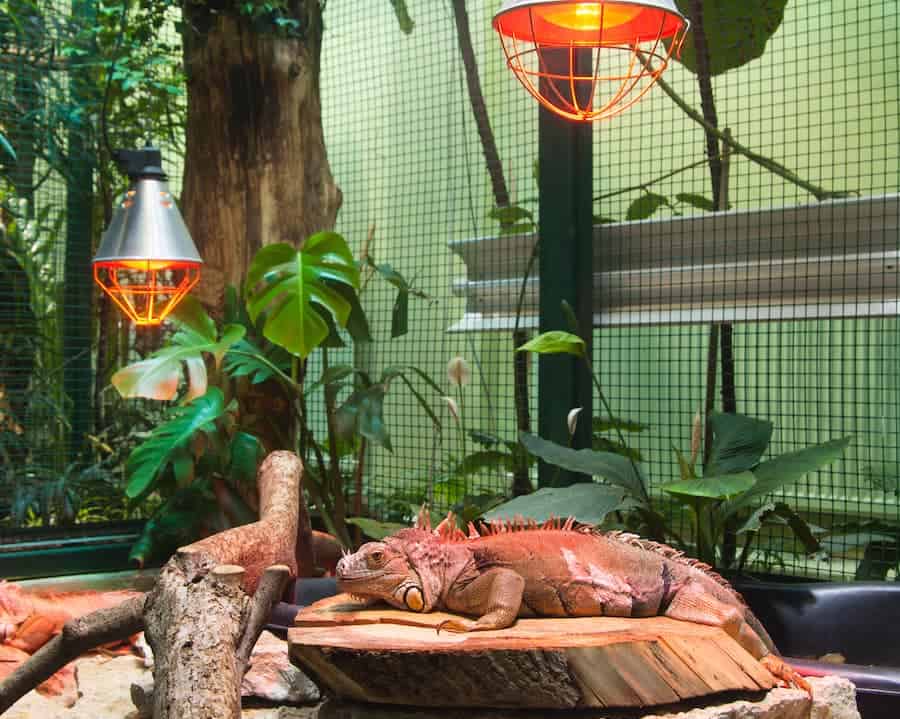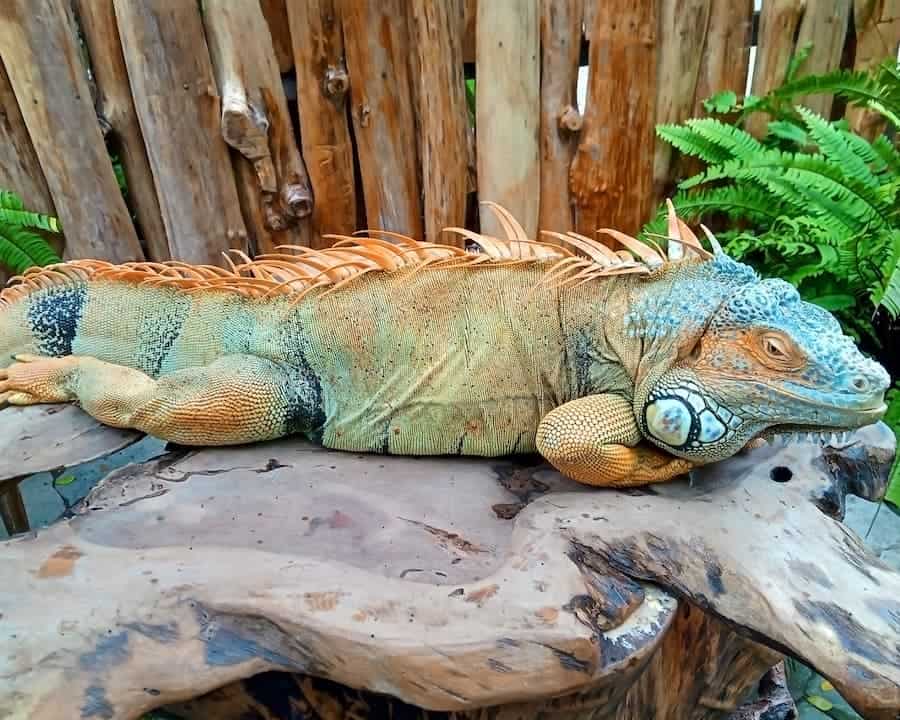Do you have enough space for your iguana? Will your enclosure be big enough for your iguana?
Iguanas of all species have a different snout-vent-length (SVL) and snout-tail-length (STL). Green iguanas can be 4.9-feet – 6.5-feet in length, but what about other species?
In the guide below, we’re going to provide you with an in-depth view of different iguana species, how big they get and answer all of your burning questions.
How Big Do Iguanas Get?
| Length | Weight | |
| Captivity | 6-feet – 7-feet | Up to 20 pounds |
| Mexico | 5+ feet | Up to 20 pounds |
| Costa Rica | 6+ feet | Up to 12 pounds |
| Puerto Rico | 6.5 feet | Up to 11 pounds |
| Florida | 5+ feet | Up to 17 pounds |
Want to learn more about iguana breeds? Read my recent post titled “5 Best Pet Iguanas: Green, Rhino, Spiny Tail, Desert, Blue.”
How Big Do Iguanas Get in Captivity?

In ideal conditions, where the iguana has an ample UVB light source, it can grow up to 6-feet in captivity, with some reaching as big as 6.5-feet.
Some sources even say that, in rare cases, they can grow to 7-feet long.
How Big Do Iguanas Get in The Wild?

Iguanas can get as big as their captive counterparts in the wild, but they must be in the right conditions to grow this large.
How Big Do Iguanas Get in Mexico?
Mexico is home to the black spiny-tailed iguana, which is a beautiful, distinct-looking reptile. These iguanas can grow up to 5+ feet in length, but most will be:
- 4’7” – males
- 3’3” – females
Females are naturally smaller in size than their male counterparts. However, you can also find other species, such as the green iguana, in the Sinaloa and Veracruz areas at a higher elevation.
How Big Do Iguanas Get in Costa Rica?
Costa Rica is home to both green and spiny-tailed iguanas. In the wild, the green iguana can reach 6+ feet in length at a maximum. The spiny-tailed iguana will grow up to 5-feet in length, or just a tad shorter.
How Big Do Iguanas Get in Puerto Rico?
Puerto Rico’s warm weather and environment allow iguanas to thrive. The green iguana will reach its typical size of 6+ feet, but there’s also the Mona ground iguana found in Puerto Rico.
The Mona ground iguana has a snout-tail-length of up to 4-feet.
Green iguanas are often called “gallina de palo” or chicken of the tree in Puerto Rico. Unfortunately, the green iguana has become an invasive species on the island in the last few decades.
How Big Do Iguanas Get in Florida?
Florida is home to the green, spiny tail and black spiny tail iguana. Southern Florida is home to most of these species, and the average iguana in the state is about 5-feet in length and 17- 20 pounds.
How Big Are Baby Iguanas?

Baby iguanas are small and cute, but they will grow to be up to 6.5-feet in length. The typical baby iguana will be:
- 2 – 4 inches in length
- 0.2 – 0.3 pounds
Iguanas grow rapidly during their first few years of life, although they’re relatively lightweight, considering their length.
How Fast Do Iguanas Grow?

Iguanas can take years to reach their full growth (more on that below), but they can grow rapidly the first year. From a hatchling, your iguana can grow from a 2.5” SVL or 6 – 9” STL to a 9” SVL and 26” STL.
However, the second year on, your iguana is likely to add 6- 8″+ in STL per year.
How Many Years Before an Iguana is Fully Grown?

Iguanas tend to go through growth spurts, and you’ll find that they can grow for up to seven years of their lives. However, many resources state that your iguana will reach full size by the time it’s four years old.
This is wrong.
At four years old, your iguana will have:
- SVL of 14 – 16″
- STL of 35 – 48”
Most iguanas will be 3 feet long when they’re four years of age and will grow until they’re as old as 7 or 8.
Do Male Iguanas Get Bigger Than Females?

Yes.
Male iguanas are longer in length and heavier than their female counterparts. Most people can immediately tell the difference between adult iguanas based on their size.
Males also have larger, muscular:
- Chests
- Legs
A male iguana will have larger jowls and a more defined dewlap.
Tips to Ensure Your Iguana Grows Big & Healthy
Proper care is crucial to your iguana reaching its maximum potential. If you don’t care for your reptile properly, it can cause them to grow slower and be unhappy as a result.
However, I know that the tips below are all you need to ensure that you can enjoy a happy, healthy and full-size iguana.
Proper Diet

Iguanas need a proper diet, and this is difficult for first-time owners to fully understand. I recommend that you follow a proper feeding ratio of:
- 40% – 50% leafy greens, consisting of a variety of veggies, such as kale, leeks, Swiss chard, carrot tops, escarole and much more. Feeding just lettuce or not understanding the importance of oxalates and phytates can lead to a malnourished iguana.
- 30% – 40% other veggies, such as mixed veggies, green beans and carrots.
- 10% – 15% fruit, such as berries (iguanas love them), mangos, kiwi, peaches, apples and many others.
- 0% – 4% grains, which should only be added on occasion and be cooked to allow for easier digestion.
Check out this post I wrote about what iguanas eat to learn more about their proper diet.
Proper UVB Lighting

Iguanas bask in the sun because they love it and will allow them to grow big and strong. Your iguana needs 12 hours of sunlight daily, and this will include a mix of natural and UVB lighting.
You must ensure that your iguana has a UVB bulb in their enclosure, with some bulbs offering UVA and UVB exposure.
Proper Temperature

Iguana enclosure temperature is one of the most important things to monitor. You will need to make use of:
- Temperature gauges
- Humidity gauges
If the enclosure reaches in excess of 100°F for a prolonged period of time, it can lead to injury. However, cold can also cause an iguana to die in the long-term.
You should have a temperature range of 80°F -85°F in most of the cage and a dedicated basking area that has a temperature of 95 – 100°F.
Supplements

Many iguana owners use supplements to help ensure their iguanas get all of the nutrients they need to grow big and healthy.
Some of the most common supplements for iguanas are:
- Calcium
- Vitamin D
- Multivitamins
Calcium is a crucial nutrient to protect your iguana’s bone and digestive health. Vitamin D can help with calcium absorption.
It’s important to remember that supplements should be used as they are intended – to supplement a healthy diet and bridge nutrient gaps.
Proper Humidity
Iguanas naturally live in humid environments. If you want to raise a big and healthy iguana, you need to ensure its terraria has enough humidity.
Ideally, the humidity levels in the enclosure should be kept at:
- 70%-85%
Some iguanas prefer humidity levels to be 90%.
If the enclosure is too dry, it can lead to kidney disease or poor shedding.
It goes without saying that your iguana can get sick and will need to see a veterinarian once or twice per year. Routine checkups can identify any disease or sickness your reptile may have and treat them rapidly.
Can Cage Size Limit Your Iguana’s Growth?

An iguana’s enclosure should be the appropriate size if you want to raise a happy, healthy pet. While cage size doesn’t directly affect an iguana’s size, it can affect its growth.
An enclosure that is too small can stress out an iguana and lead to unhealthy living conditions. Both of these factors can ultimately stunt your iguana’s development.
There’s also a misconception that an iguana will grow to the size of its cage. Like any other reptile, iguanas have a limit to how big they can grow.
However, if your enclosure is too small, other factors, such as poor living conditions, can ultimately affect its size.
How Big Do Other Iguana Breeds Get?
| Length | Weight | |
| Green Iguana | 5 feet | 6.6 pounds – 8.8 pounds |
| Blue Iguana | 5+ feet | Up to 31 pounds |
| Spiny Tailed Iguana | 10 inches – 5 feet | 2.2 ounces – 2+ pounds |
| Rhino Iguana | 4.5 feet | 10 – 20 pounds |
| Marine Iguana | 3.3 feet | 3 pounds |
How Big Do Blue Iguanas Get?

The blue iguana can reach a length of 5+ feet and weigh around 30 pounds. These big lizards are native to the Grand Cayman and are known for their stunning blue and turquoise colors.
It’s important to remember that this iguana, like other species of this reptile, will only reach this maximum height and weight if it’s:
- Fed a healthy, balanced diet
- Raised in a proper enclosure with the right heat, humidity and light levels
How Big Do Spiny Tailed Iguanas Get?

The length and weight of a spiny tailed iguana can vary greatly depending on the type.
- The Yucatan spiny-tailed iguana is small and can reach just 10” in length.
- The black spiny-tailed iguana can grow up to 5’ in length.
These iguanas are native to Central America and Mexico.
How Big Do Rhino Iguanas Get?

Rhino iguanas can grow to 4.5 feet and weigh up to 20 pounds. These large iguanas are heavy-bodied.
While they’re not as long as the common green iguana, the rhino iguana can be twice as heavy as their green cousins.
Males have horned-shaped protrusions on their heads, which is what gives them their name.
How Big Do Marine Iguanas Get?

Marine iguanas can grow to 2-3.3 feet in length and weigh up to 3 lbs. These lizards are native to the Galapagos Archipelago and live along rocky coastlines.
Marine iguanas can forage at sea. Their smaller size makes it easier to forage and hide from predators.
Did you know that marine iguanas are the only iguana species that spends time in a marine environment? But they’re not the only iguanas that can swim. You can learn more about iguana swimming habits in my post “Can Iguanas Swim? Everything You Need to Know.”
FAQ
Does Salmonella Affect How Big an Iguana Gets?
No, salmonella does not typically affect an iguana’s size.
In fact, most iguanas really aren’t affected by salmonella and don’t require treatment. Treatment isn’t usually effective for salmonella anyway.
Are you concerned that your iguana may have salmonella? I recommend reading “Do All Iguanas Carry Salmonella & How to Protect Your Pet.”
Does Metabolic Bone Disease Affect How Big an Iguana Gets?
Metabolic Bone Disease can affect an iguana’s size. The disease can result in loss of appetite and bent or broken bones.
Iguanas can develop Metabolic Bone Disease when calcium and phosphorus levels are abnormally low.
It is crucial to ensure you’re feeding your iguana a balanced diet and that they are getting enough sunlight either through natural exposure or UV light.
Iguanas need a balanced diet and proper sun exposure to maintain healthy calcium levels.
Do Petco Iguanas Also Grow Big?
Yes, Petco iguanas can also grow big. This pet store sells green and blue iguanas, which can grow to be up to 5+ feet long.
If you purchase an iguana from Petco or another pet store, make sure that you understand that these lizards grow quickly and will need a large enclosure.
The iguanas sold at big-box pet stores are no different in terms of size than one you would get from a breeder.
How Big of a Cage Does a Fully Grown Iguana Require?
In his book, iguana expert James W. Hatfield, author of “Green Iguana The Ultimate Owner’s Manual,” recommends an enclosure that is 8’ wide and 6’7” tall.
An enclosure of this size should easily accommodate a green iguana and provide him with the space he needs to live comfortably.
Larger iguana species will need even bigger enclosures.
Iguanas need space for horizontal and vertical movement. They need to be able to walk around, explore, drink, eat, climb onto branches and bask in the light and heat.
If an iguana’s enclosure is too small, it can cause stress, aggression, loss of appetite and depression.
How Tall Do Iguanas Get?
The height of a green iguana can range from 1.46”-2.05.”
Some species, like the Marine Iguana or the Blue Iguana are taller and much longer than the green iguana.

